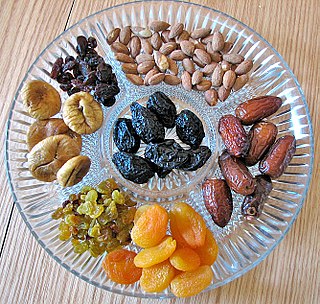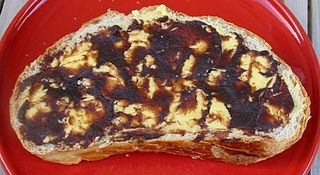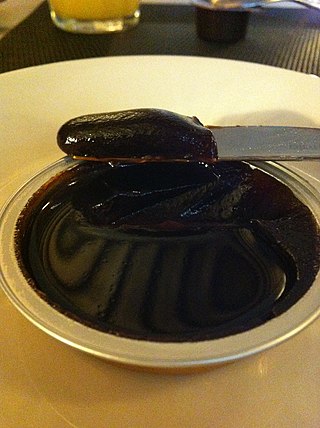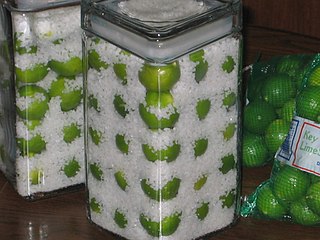
Food preservation includes processes that make food more resistant to microorganism growth and slow the oxidation of fats. This slows down the decomposition and rancidification process. Food preservation may also include processes that inhibit visual deterioration, such as the enzymatic browning reaction in apples after they are cut during food preparation. By preserving food, food waste can be reduced, which is an important way to decrease production costs and increase the efficiency of food systems, improve food security and nutrition and contribute towards environmental sustainability. For instance, it can reduce the environmental impact of food production.

A chutney is a spread typically associated with cuisines of the Indian subcontinent. Chutneys are made in a wide variety of forms, such as a tomato relish, a ground peanut garnish, yogurt, or curd, cucumber, spicy coconut, spicy onion, or mint dipping sauce.

Polish cuisine is a style of food preparation originating in and widely popular in Poland. Due to Poland's history, Polish cuisine has evolved over the centuries to be very eclectic, and shares many similarities with other national cuisines. Polish cooking in other cultures is often referred to as à la polonaise.

Dried fruit is fruit from which the majority of the original water content has been removed either naturally, through sun drying, or through the use of specialized dryers or dehydrators. Dried fruit has a long tradition of use dating back to the fourth millennium BC in Mesopotamia, and is prized because of its sweet taste, nutritive value, and long shelf life.

Jewish cuisine refers to the worldwide cooking traditions of the Jewish people. During its evolution over the course of many centuries, it has been shaped by Jewish dietary laws (kashrut), Jewish festivals and holidays, and traditions centred around Shabbat. Jewish cuisine is influenced by the economics, agriculture, and culinary traditions of the many countries where Jewish communities have settled and varies widely throughout the entire world.

Apple butter is a highly concentrated form of apple sauce produced by long, slow cooking of apples with apple juice or water to a point where the sugar in the apples caramelizes, turning the apple butter a deep brown. The concentration of sugar gives apple butter a much longer shelf life as a preserve than apple sauce.

Pickling is the process of preserving or extending the shelf life of food by either anaerobic fermentation in brine or immersion in vinegar. The pickling procedure typically affects the food's texture and flavor. The resulting food is called a pickle, or, if named, the name is prefaced with the word "pickled". Foods that are pickled include vegetables, fruits, mushrooms, meats, fish, dairy and eggs.

A fruit butter is a sweet spread made of fruit cooked to a paste, then lightly sweetened. It falls into the same category as jelly and jam. Apple butter and plum butter are common examples, but fruit butters can be made from any firm fruit. Fruit pastes, such as quince cheese are popular in Latin American countries, are similar but more highly sweetened and jelled. They are sold in shallow tins or as wrapped bricks, while fruit butters usually come in wide-mouthed jars and are more common in Central and Eastern Europe.

The following outline is provided as an overview of and topical guide to the preparation of food:

Fruit preserves are preparations of fruits whose main preserving agent is sugar and sometimes acid, often stored in glass jars and used as a condiment or spread.
Azerbaijani cuisine is the cooking styles and dishes of the Republic of Azerbaijan. The cuisine is influenced by the country's diversity of agriculture, from abundant grasslands which historically allowed for a culture of pastoralism to develop, as well as to the unique geographical location of the country, which is situated on the crossroads of Europe and Asia with access to the Caspian Sea. The location has enabled the people to develop a varied diet rich in produce, milk products, and meat, including beef, mutton, fish and game. The location, which was contested by many historical kingdoms, khanates, and empires, also meant that Azerbaijani cuisine was influenced by the culinary traditions of multiple different cultures, including Turkic, Iranian, and Eastern European.

Bacon jam is a bacon-based relish, similar to the Austrian starter Verhackertes. It is made through a process of slow cooking the bacon, along with onions, vinegar, brown sugar and spices, before mixing it in a food processor. In 2015, Martin and Suzie Cowley of Wales claimed to have invented Bacon Jam. However, Chef Mike Oraschewsky stated they started making Bacon Jams in 2013. Josh Henderson of Skillet Street Foods has been selling Bacon Jam as of 2010.

Sirop de Liège is a Belgian jam or jelly-like spread. Apple and pear are principally used, often with dates: other fruit such as apricot can be used as well. Sugar and other sweeteners are not normally needed.

Pickled fruit refers to fruit that has been pickled. Pickling is the process of food preservation by either anaerobic fermentation in brine or immersion in vinegar. Many types of fruit are pickled. Some examples include peaches, apples, crabapples, pears, plums, grapes, currants, tomatoes and olives. Vinegar may also be prepared from fruit, such as apple cider vinegar.
Kaong palm vinegar, also known as irok palm vinegar or arengga palm vinegar, is a traditional Filipino vinegar made from the sap of the kaong sugar palm. It is one of the four main types of vinegars in the Philippines, along with coconut vinegar, cane vinegar, and nipa palm vinegar. It is usually sold under the generic label of "palm vinegar".

Ashkenazi Jewish cuisine is an assortment of cooking traditions that was developed by the Ashkenazi Jews of Central, Eastern, Northwestern and Northern Europe, and their descendants, particularly in the United States and other Western countries.

Moravian cuisine encompasses the cooking styles, traditions and recipes associated with Moravia, a region of the Czech Republic and historically belongs to the Moravia, former historical country in Central Europe. Today, it is often perceived as an integral part of Czech cuisine, to which it has over the last century been artificially accommodated and mixed. Nevertheless, there is a large list of dishes, drinks and customs that are original only for Moravia.
















